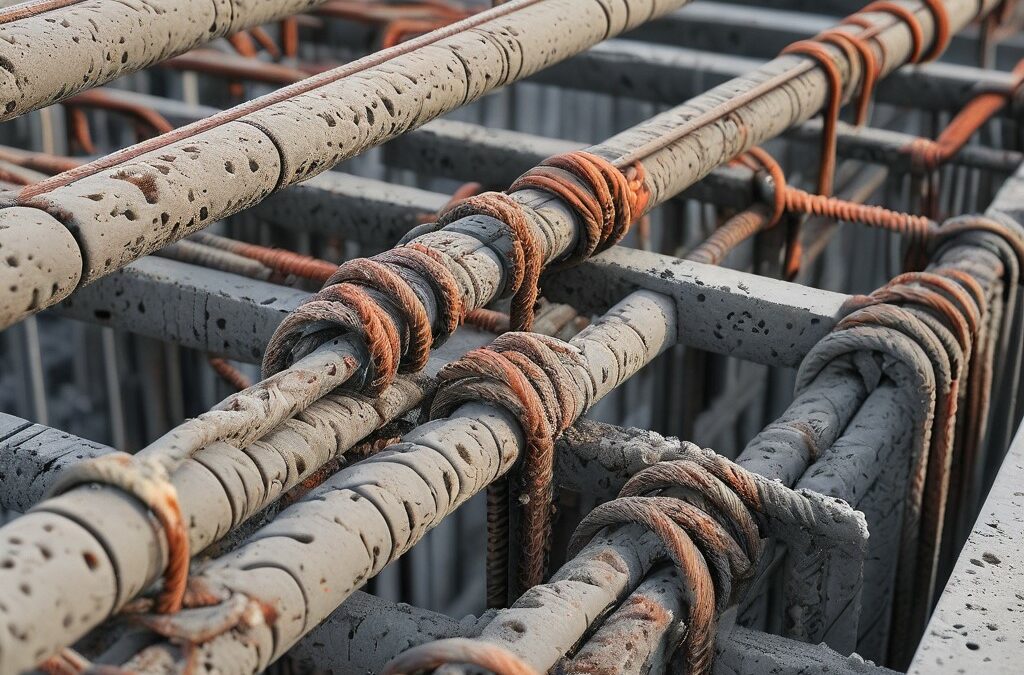The cart is empty!
Understanding the Impact of Corrosive Environments on Concrete
The longevity of concrete structures is crucial to the safety and functionality of buildings, bridges, and other infrastructure. In corrosive environments, where exposure to aggressive agents accelerates degradation, maintaining the durability of concrete is critical.
In this article, we examine how corrosive environments impact concrete structures and discuss essential measures to mitigate damage caused by corrosion.
What Causes Corrosion in Concrete Structures?
Corrosion in concrete is driven by chemical and physical processes.
Steel in concrete is, strangely, usually at a low risk of corrosion. The highly alkaline nature of concrete produces stable microscopic surface corrosion that prevents any chemical reactions. Unfortunately, high levels of chlorides or sulphides can penetrate this layer, or carbon dioxide can neutralise the pH of the concrete; both of which allow the steel bars to start rusting.
Physically, factors like freeze-thaw cycles and abrasion can exacerbate the wear and tear, further accelerating the degradation process.
Understanding the Corrosive Environment
Primarily, we are concerned with three types of environments in which concrete structures are built:
1. Marine Environments
Marine environments pose significant challenges due to the high salinity of seawater. Saltwater spray and immersion expose concrete to chlorides, leading to rapid reinforcement corrosion.
2. Industrial Environments
Industrial areas are often laden with pollutants. Carbon dioxide reacts with concrete, reducing its pH and allowing the steel to corrode.
3. Urban Environments
Urban settings, and roadways (especially highway bridges) with their elevated levels of carbon dioxide from vehicle emissions, contribute to carbonation. This process lowers the alkalinity of concrete, diminishing its protective capabilities against steel corrosion.
Strategies for Mitigating and Preventing Corrosion in Concrete
From structural design through materials selection and to monitoring and maintenance, there are a multitude of strategies that we can employ to mitigate and prevent corrosion in concrete.
Structural Design Considerations
Understanding that corrosion can significantly reduce the load-bearing capacity of concrete structures, architects and designers must ensure that structures maintain their integrity and safety throughout their service life.
Incorporating durability into the design phase involves selecting appropriate materials, specifying protective measures, and designing for environmental conditions. Ensuring adequate cover to reinforcement and proper drainage systems are also vital.
Materials and Mix Design for Enhanced Durability
When considering materials to be used in the construction of concrete structures, designers can incorporate:
· High-Performance Concrete (HPC)
High-performance concrete (HPC) is engineered to exhibit superior properties, including lower permeability and higher strength. These characteristics make HPC more resistant to ingress of corrosive agents.
· Supplementary Cementitious Materials (SCMs)
Incorporating materials like fly ash, slag, and silica fume into concrete mixes can significantly enhance durability. SCMs reduce the permeability and improve the microstructure of concrete. However, they can also adversely affect the pH, and so must be used with caution.
Use of Protective Coatings and Sealants
Epoxy coatings, polyurethane sealants, and silane-siloxane treatments are commonly used to protect concrete surfaces. These coatings create a barrier that prevents the ingress of water and harmful chemicals.
Proper surface preparation and application methods are crucial for the effectiveness of protective coatings. Techniques such as spray application, brush application, and trowel application are employed based on the specific requirements of the project.
However, while protective coatings provide immediate protection, their long-term performance depends on factors like environmental conditions, application quality, and maintenance practices.
Monitoring and Maintenance Strategies
When it comes to corrosion in concrete, no concrete structure is ‘set and forget. We must continually monitor for structural integrity and instigate effective maintenance regimens. To achieve this, we turn to methods such as non-destructive testing, routine inspections, and predictive maintenance:
- Non-destructive testing methods include techniques such as half-cell potential mapping, ground-penetrating radar, ultrasonic pulse velocity, and infrared thermography are used to assess the condition of concrete structures without causing damage. These methods help to identify early signs of corrosion and other defects.
- Regular inspections, such as visual inspections combined with more detailed testing, help to detect and address issues before they escalate, thus ensuring that maintenance can be planned and executed effectively. In particular, the expansive nature of rebar corrosion can cause cracking and spalls before the structure loses strength (mostly) and this can act as an effective early warning system.
- Advanced predictive models use data from inspections and monitoring to forecast future deterioration. This proactive approach enables timely interventions, reducing the risk of unexpected failures.
Corrosion Control in Infrastructure Cannot be Ignored
Failures of concrete structures because of corrosion in concrete can have disastrous consequences. Analysing failures, such as the collapse of the Morandi Bridge in Genoa that caused 43 people to lose their lives, highlights the importance of proper design, materials selection, and maintenance. We cannot and must not ignore corrosion control in infrastructure. The lessons we learn guide future practices to help us avoid similar outcomes.
When we apply all that we have learned, we can create structures and complete projects like the Burj Khalifa and the Millau Viaduct that showcase the successful application of advanced materials and techniques.
In summary, ensuring the long-term durability of concrete structures in corrosive environments requires a multifaceted approach. From material selection and mix design to protective measures and maintenance strategies, each aspect plays a critical role in enhancing the resilience and longevity of concrete infrastructure. Continuous research and innovation will further bolster our ability to combat the challenges posed by corrosive environments. Continuous upgrade and certification will ensure the durability of your career in the concrete environment.
The Institute of Corrosion supports learning and advancement in all fields within the corrosion industry. These include:
- Fundamentals of Corrosion
- Coating and Inspection Training
- The Cathodic Protection, Training, Assessment and Certification Scheme, with specialist courses that include Cathodic Protection in Concrete
Just as our concrete infrastructure should be, these courses are designed to be future-proofed, continually updated as we learn more, and regulations and standards evolve to ensure that all we learn is embedded into best practice.


